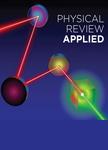版权所有:内蒙古大学图书馆 技术提供:维普资讯• 智图
内蒙古自治区呼和浩特市赛罕区大学西街235号 邮编: 010021

作者机构:Scintillation Materials Research Center University of Tennessee Knoxville Tennessee 37996 USA Department of Materials Science and Engineering University of Tennessee Knoxville Tennessee 37996 USA Physical Science Division IBM Thomas J Watson Research Center Yorktown Heights New York 10598 USA Department of Computer Science University of Illinois at Urbana-Champaign Urbana Illinois 61801 USA Department of Nuclear Engineering University of Tennessee Knoxville Tennessee 37996 USA Department of Physics Wake Forest University Winston-Salem North Carolina 27109 USA Department of Chemical and Biomolecular Engineering University of Tennessee Knoxville Tennessee 37996 USA
出 版 物:《Physical Review Applied》 (Phys. Rev. Appl.)
年 卷 期:2017年第8卷第3期
页 面:034011-034011页
核心收录:
基 金:U.S. Department of Homeland Security, DHS Domestic Nuclear Detection Office, DNDO, (2012-DN-077-ARI067-06) Domestic Nuclear Detection Office, DNDO
主 题:Crystal defects Crystal growth Dopants Luminescence Point defects Solid-state detectors Medical imaging Scintillators
摘 要:Eu2+-doped alkali or alkali earth iodide scintillators with energy resolutions ≤3% at 662 keV promise the excellent discrimination ability for radioactive isotopes required for homeland-security and nuclear-nonproliferation applications. To extend their applications to x-ray imaging, such as computed tomography scans, the intense afterglow which delays the response time of such materials is an obstacle that needs to be overcome. However, a clear understanding of the origin of the afterglow and feasible solutions is still lacking. In this work, we present a combined experimental and theoretical investigation of the physical insights of codoping-based defect engineering which can reduce the afterglow effectively in KCaI3:Eu2+ single-crystal scintillators. We illustrate that Sc3+ codoping greatly suppresses the afterglow, whereas Y3+, Gd3+, or La3+ codoping enhances the afterglow. Meanwhile, a light yield of 57 000 photons/MeV and an energy resolution of 3.4% at 662 keV can be maintained with the appropriate concentration of Sc3+ codoping, which makes the material promising for medical-imaging applications. Through our thermoluminescence techniques and density-functional-theory calculations, we are able to identify the defect structures and understand the mechanism by which codoping affects the scintillation performance of KCaI3:Eu2+ crystals. The proposed defect-engineering strategy is further validated by achieving afterglow suppression in Mg2+ codoped KCaI3:Eu2+ single crystals.